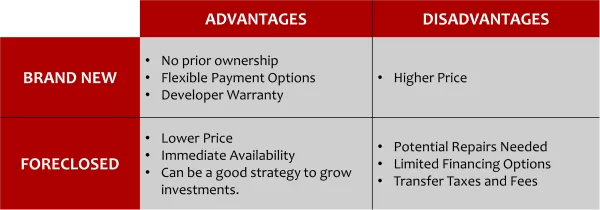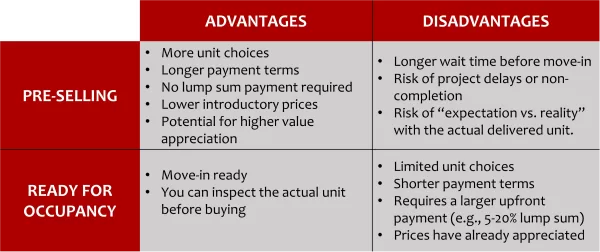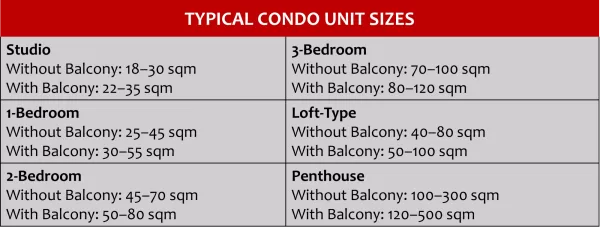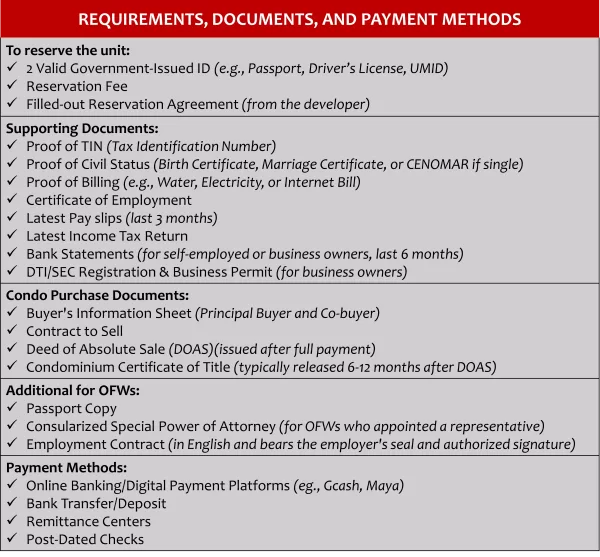Whether you’re starting a family, moving out on your own, or investing in real estate, buying your first property is a significant milestone.
Urban living has become essential for many due to its proximity to work, universities, and other key establishments. This has led to the rise of condominiums, which offer a more affordable alternative to traditional homes in the urban areas.
To guide you on your first condo-hunting journey, we’ve compiled essential tips and must-knows.
1. Define Your Purpose For Buying
First things first, know what the condo unit is for. If you’re treating it as an investment, prioritize ROI. Otherwise, if it will be your home, focus on personal preference and convenience.
If you plan to have it rented out, studio units located in central business districts (CBDs) or near universities are generally preferred due to high demand from young professionals, students, and short-term guests. Plus, they are easier to maintain. If you plan to enroll your property on booking platforms like Airbnb and Agoda, it’s also better to choose condos with premium amenities like swimming pools, lounges, and gyms in order to increase pricing.
The strategy above also applies to resale investments, as studio units in high-demand locations tend to have a broader market, attracting both fellow investors and individuals looking to own rather than rent.
On the other hand, a condo for personal use should be tailored to your specific needs. For example, a two- or three-bedroom unit is perfect if you’re moving in with your family.
Without a clear purpose, you risk overspending or choosing a unit that doesn’t fit your needs.
2. Conduct Research Before Inquiring
Many buyers rely solely on realtors. While some realtors genuinely care, others may prioritize their own interests. Be sure to conduct your own research first before jumping right in. For instance, there’s a good time and a bad time to buy property.
According to Leechiu Property Consultants, the mid-market condominium segment is currently experiencing a downturn, driven by high vacancy rates that are pushing rental prices down. An oversupply of condominium units in Metro Manila, as of November 2024, is adding to the problem—projected to take nearly three years to absorb.
This situation suggests that condos for rental income and resale may not be promising at the moment.
On the bright side, situations like this usually push developers to offer discounts and flexible payment options—great opportunities for buyers to snag a good deal.
So, when is the right time to buy?
- When interest rates are low, as borrowing money for a mortgage can be cheaper.
- When the market is stable or slightly down, as property prices can fluctuate due to demand, economic conditions, and geopolitical factors.
- When infrastructure projects are underway, they will significantly increase property demand and prices in the future.
- When a developer offers a promo discount.
- When you are ready financially.
Stay updated with current news and events!
3. Brand New vs Foreclosed, Pre-selling vs RFO
You’ve probably heard these property buzzwords before, but let’s dive deeper as they impact the price, payment terms, risks, and move-in time.
Brand New vs. Foreclosed Units
Brand New – a newly constructed unit that has never been owned nor occupied
Foreclosed – a previously owned unit that has been repossessed by a bank or lender due to the previous owner’s failure to settle the mortgage and/or government’s property tax

Brand new units are usually sold at a higher price by developers, either as pre-selling (still under construction) or RFO (ready for occupancy). While foreclosed units, being previously owned, are typically sold below market value in auctions such as bank direct listings or Pag-IBIG public auctions.
Pre-selling vs. RFO (Ready For Occupancy)
Pre-selling – still under construction or in the planning phase
RFO (Ready for Occupancy) – a fully or partially completed condo available for immediate move-in after purchase

If you need a unit immediately, choose RFO. If you can wait, pre-selling offers greater potential for value appreciation.
4. Spot the Right Location
Location is probably the most important factor to consider. Ideally, it should be near offices, schools, or anywhere convenient. If you can’t find a condo in your preferred area, consider the ones with easy access to transport hubs and alternative routes to avoid traffic.
CBDs have the highest concentration of condominiums, but for remote workers or those with location flexibility, less commercialized areas can offer bigger space at a lower cost.
For investors, areas that aren’t fully developed yet but have big growth potential are worth checking out. For example, future developments such as the Metro Manila Subway and new LRT/MRT lines extensions could significantly increase the value of properties nearby in the coming years.
Bonus Tip: Assess how likely the area would be affected by hazards such as floods, earthquakes, and storm surges for added peace of mind. You may use fault line maps and the NOAH app developed by the University of the Philippines for this.
5. Choose a Trustworthy Real Estate Developer
Finding an affordable condo with great location and amenities is important, but don’t overlook the developer’s reputation. Many buyers discover issues only after purchasing—ranging from poor maintenance to security concerns and mismanagement.
Each developer has its own strengths. SMDC, for example, is known for accessibility and mall integration. Their residential properties are usually within walking distance from their commercial developments.
Another key player in the market is DMCI, known for creating pet-friendly communities and spacious buildings enhanced by their trademarked Lumiventt® Technology, which allows natural light and fresh air to flow in, resulting in brighter and cooler living spaces.
With strengths come weaknesses. For instance, SMDC properties are often not pet-friendly and have high unit volumes, sometimes reaching up to 45 units per floor. On the other hand, DMCI’s locations are generally less accessible than SMDC’s.
Get to know the reputable real estate developers available and be sure to read reviews from residents online for valuable insights.
6. Find a Trustworthy Realtor
As a buyer, you can purchase a unit without a realtor by dealing directly with banks or Pag-IBIG (for foreclosed units) or real estate developers through their websites. However, working with a reliable realtor offers valuable benefits—they provide expert insights, handle paperwork and legalities, and guide you through the entire buying process. However, beware of scams—they’re everywhere. If you choose to work with a realtor, verify their company ID and conduct an online background check.
7. Set Your Budget
Assess how much of your savings and monthly income you can set aside for the condo unit, and search for the best condo options that match your budget. You can use a Home Budget Calculator to determine a personalized budget for you.
If you’re on a tight budget, focus on essential over luxury features. For instance, prioritize a convenient location with access to work or public transport over high-end amenities like a pool or gym.
8. Find the Perfect Condo Development
Condo buildings are classified as High-rise, Mid-rise, and Low-rise.
High-rise condos (10 floors and up) offer great city views. They usually have the best amenities, hence, they are also generally more expensive and with higher monthly condo dues.
Mid-rise condos (5 to 9 stories) are usually found in less busy areas. They are perfect for anyone seeking a comfortable mix of city access and community living.
Low-rise condos (1 to 4 stories) are usually situated in suburban or provincial areas where space is more abundant. These buildings often don’t have elevators and offer fewer amenities, but they make up for it with affordability and lower population density.
Photos and brochures can often be filtered and misleading, so it’s always better to conduct ocular visit to assess the neighborhood, security, noise levels, cleanliness, construction quality, and unit finishes.
In addition, real estate developers often partner with property management companies to oversee long-term operations. Each management has its own set of rules covering significant aspects such as:
Association Dues: Monthly or annual fees for property maintenance and amenities.
Pet Policies: Restrictions on pet size, species, or total number allowed.
Occupancy Limits: Maximum number of residents per unit.
Visitor Regulations: Rules for guest stays, parking, and security access.
For pet owners, be sure to check with your realtor about pet policies. In the meantime, here are 20 pet-friendly condominiums in Metro Manila you might want to check out.
9. Determine Your Preferred Condo Unit Specs
Size and Number of Rooms
Condo units can be either Studio, 1-BR, 2-BR, 3-BR, Loft-type, or Penthouse—each available with or without a balcony.
Please refer to the typical sizes of each type below:

Tip: Calculating the price per square meter gives you a clearer understanding of a property’s cost relative to its size.
Formula: Property Total Cost ÷ Total Number of Square Meters
Example: A 1-BR unit with a size of 35 sq.m. costing ₱5,000,000 VS. a 2-BR Unit with a size of 40 sq.m. costing ₱6,000,000, both located in BGC
₱5,000,000 ÷ 35 sq.m. = ₱142,857 per square meter VS. ₱6,000,000 ÷ 40 sq.m. = ₱150,000 per square meter
Calculating the price per square meter allows you to compare different properties and identify which one offers the best value for space.
Deliverables
Condo deliverables refer to the standard features and finishes of a unit. Typical deliverables are Bare, Basic-Finished, Standard-Finished, and Fully-Furnished.




A bare unit may come with more finishes than shown in the photo—such as basic tiled flooring and painted walls. Similarly, a fully-furnished unit might be less upgraded than shown. Unit sizes and deliverables vary depending on the developer and whether the project is categorized as budget, mid-range, or high-end.
Bottomline: Bare Unit allows full customization, Basic Finish is move-in ready but unfurnished, Standard Finish is also move-in ready needing only personalized furniture and appliances, and Fully-Furnished comes complete with furniture, appliances, and décor.
Choosing a unit is where you’ll want to be extra picky—and rightfully so! Additional key points to note:
- East-facing units for the morning sun and a cooler afternoon.
- Not facing busy roads for a quieter environment.
- Proximity to elevators and fire exit.
10. Study the Quotation
A quotation (computation) typically details unit information, total amount payable, and payment terms. Always ask for a detailed breakdown.
Here’s a preview of what a quotation looks like:

- List Price – or the initial asking price set by the seller or developer.
- VAT (Value-Added Tax) – of 12% is imposed on condo unit purchases that amount to 3,600,000 and above. (For Parking Slots, however, are automatically VAT-able regardless of price)
- Other Charges – is charged for administrative and handling fees, documentary stamp tax, transfer fees, registration fees, and other legal fees. It could range from 6% to 12%.
- Reservation Fee – typically ranges from ₱10,000 to ₱100,000, is paid to secure your chosen condo unit for a specific period (30 to 60 days). It is then deducted from the total price or down payment and is generally non-refundable.
- Payment Terms – the conditions under which the buyer is expected to make payments for the property outlining the schedule and amount
Make sure to follow your payment terms accordingly as there could be penalties for delinquency or late payments.
Some realtors offer only 1–2 payment term options to simplify choices, but it’s worth asking if other options are available that might work better for you.
Additionally, inquire about hidden and future charges, as not all costs may be disclosed upfront, such as Move-in fees and Real Property Tax.
11. Requirements, Documents, and Payment Methods
You’ve finally found the perfect condo and are ready to reserve your unit (or units). Now, let’s go over the requirements and documents you’ll need throughout the acquisition process.
Here’s a handy checklist for you:

Requirements may vary for Filipino buyers, OFWs, and foreign nationals. The list above covers the usual requirements, but developers or sellers may ask for additional documents.
Conclusion
As a first-time condo buyer, knowledge is your best defense.
With an increasingly competitive market, take time to explore your options and assess the pros and cons. No condominium offers everything, so focus on what truly matters to you and be willing to compromise where necessary. Always revisit your purpose for buying at every step to ensure your decision aligns with the goal you set from the start.
And remember—once you make a reservation, there’s no going back. Reservation fees are non-refundable. Your hard-earned money deserves a well-thought-out decision.



Leave a Reply